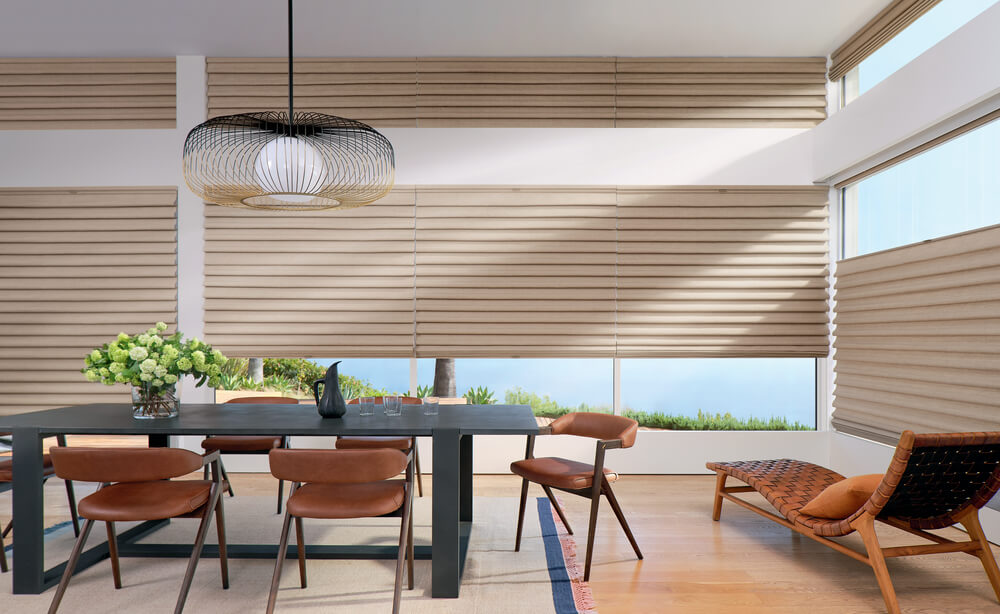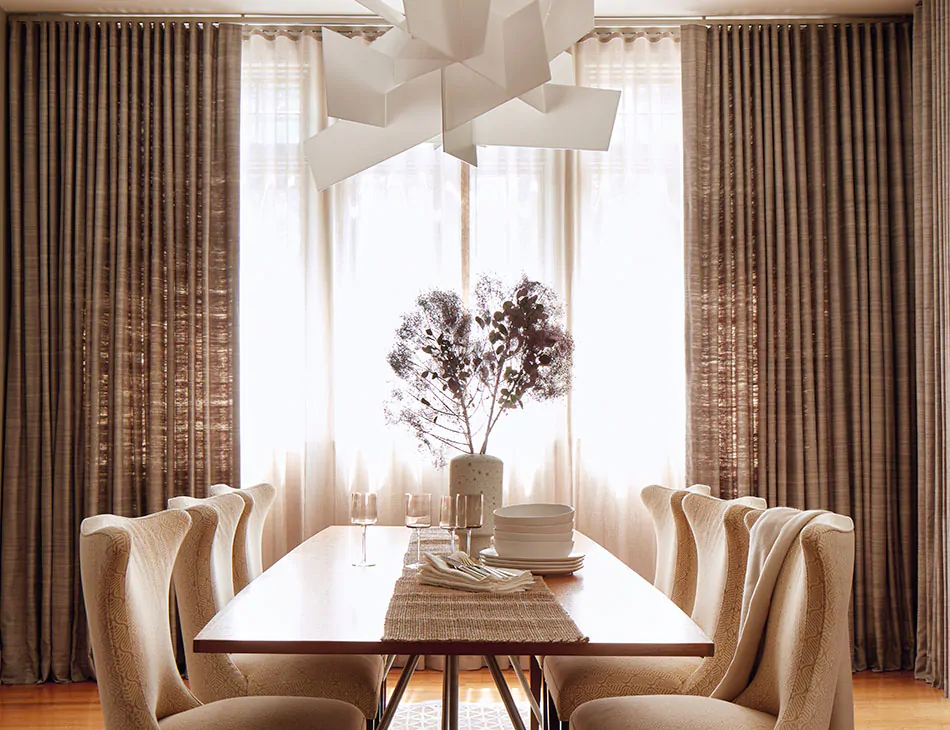Your Journey to a Beautiful Home Starts at Sunshine Drapery
Receive a complimentary professional in-home design consultation today!

As awareness about the impact of individual carbon footprints expands into buying consciousness, a push towards sustainability and eco-awareness influences consumer choices and spending habits. Sustainability in fashion showcases the trend towards eco-friendly consumerism, and 'green' interior design trends now influence the style of the home and the fabrics and materials within each room.
Sustainable window coverings support an eco-friendly and greener lifestyle. What are sustainable window coverings? Discover organic, sustainable, eco-friendly fabrics and materials and decorate the home with earth-friendly beauty.
Choosing sustainable and eco-friendly fabrics helps decrease an individual's carbon footprint and lessen the harm to our fragile planet. The best eco-friendly fabrics are derived from plants, the hair of animals, and even grass!

An eco-friendly fabric or material leaves minimal to no environmental damage. While some fabrics like polyester are plastic and fail to decompose in landfills properly, eco-friendly fabrics are designed from natural fibers and materials.
Eco-friendly fabrics include:
Cotton fabric is derived from the cotton plant. The plant yields small pods that pop open to reveal the fuzzy boll we call cotton. The bolls of the cotton plant are harvested, and the puffy white fluff is spun to create cotton thread and yarn for clothes, draperies, linens, and more!
Organic cotton refers to fabric from plants grown without synthetic fertilizers, pesticides, etc. Organic cotton is often priced higher.
Linen is a fabric derived from the flax plant. Linen has a rougher texture compared to cotton. However, it also tends to dry quicker. Some individuals don't like linen as it also is prone to wrinkling (even more so than cotton).
Silk fabric is woven from the silkworm! The fibers are extremely delicate and feature a luxurious sheen. Silk is a luxury fabric that commands a higher price due to the labor-intensive process
required to harvest the fabric. The silk from the silkworm's cocoon must be spun into a thread that is then used to create clothing, bed linens, window coverings, and upholstery fabric. China produces the most silk in the world; the famous ‘Silk Road' began in Xi'an (China) and ended in Anatolia.
Hemp is derived from the hemp cannabis plant. Many assume that hemp is the same as marijuana; however, while they are both the same type of cannabis plant, there is one defining difference: THC content. Marijuana is cannabis with more than 0.3 percent THC, and hemp has less than 0.3 percent.
Industrial hemp is used to create fabric for various purposes, including clothing, draperies, and even bags. The fibers are rougher, and Textile Exchange explains that hemp is one of the toughest fabrics available.
Bamboo fabric is woven from bamboo plants but comes with environmental caution. Sewport explains that fabrics made with bamboo can be a sustainable option, but some manufacturers do not abide by good eco-friendly practices. In some factories, workers creating the fabric might be exposed to chemicals or other dangers.
Wool is a heavier fabric that is produced from the coats of sheep. The adult sheep are sheared, and their fluffy coats are spun into wool fiber. Wool, like many other sustainable fabrics, can be organically produced. While wool is popular for clothing, luxury carpets, and blankets, this fabric also is used for draperies.
Consumers often see fabrics referred to as sustainable and eco-friendly. What is the difference between these two terms?
Many define 'eco-friendly' as a material or process that does not harm the planet or the environment. However, 'sustainability' or sustainable materials denote long-term environmental benefits (for future generations). Solar power, for example, is both eco-friendly and sustainable.
Sustainable fabrics don't simply minimize environmental harm; they also help preserve the planet for future generations. The most sustainable fabrics might also be made from recycled or organically-produced materials.
Silk is not beloved by every consumer. As this fiber is produced from the silkworm's cocoon, those who wish to embrace plant-based fabrics like cotton, linen, and hemp might steer clear. According to the People for the Ethical Treatment of Animals (PETA), about 3,000 silkworms are killed for every pound of silk.
As this fabric is derived from the silkworm cocoon, the worm must be killed to harvest the silk. The cocoon encapsulates the worm as it goes through the process of metamorphosis. The fibers cannot be harvested or produced without the worm spinning the cocoon for this transformational process. The fabric is not vegan since silk is produced from a living insect.
Eco-friendly materials manufacturing and overall sustainability all contribute to the ethical desirability of a fabric. What is the most ethical fabric?
The BBC made a list of materials that could help preserve the planet. The first on the list was Pinatex, also known as pineapple leather. While this might not be an ideal fabric for drapery, it could be ideal for furniture upholstery! Organic cotton, linen, and wool also made the list.
Of all the ethical materials listed by the BBC, organic cotton might be the most ideal for drapery fabric. This fabric can be woven into either heavy or light weave designs. Cotton also combines well with other fabrics to create customized drapery panels.
Hemp weaves into fashion to create sustainable and eco-friendly clothing; this material is also used for bracelets and necklaces. As hemp fabric jumps in popularity, the textile can also create customized shades and drapery.
Wood is natural and eco-friendly. Wood blinds and shutters create classic and classy window coverings that allow homeowners to control the light illuminated in the room. Sunshine Drapery offers wood blinds and shutters in many styles, colors, and wood varieties.
Natural Oak Wood Blinds
Oak blinds offer incredible durability and can be stained to match the decor hues in a room or blend into other wood details.
Bamboo Wood Blinds
Bamboo blinds are another beautiful wood variety that offers amazing durability. Homeowners can choose natural wood to showcase the grain for a rustic design touch.
| Fabric | Origin | Highlighted Features |
| Silk | The cocoon of the silkworm. | Luxurious with a lustrous sheen, silk is a high-end fabric that is used to create stunning draperies. |
| Linen | Flax | Linen is a rougher fabric that's also durable. It dries faster than cotton, too. |
| Cotton | Cotton plant | Soft and lightweight, cotton is known for its breathability and affordability. |
| Hemp | Cannabis plant | Hemp is one of the most durable textiles, and it's becoming a popular choice for shades and some drapery fabrication, too. |
| Wool | Sheep | Heavy and durable, high-quality wool is a sustainable and classic choice. Some might find that the price for wool textiles is higher, though. |
| Bamboo | Bamboo plant | Bamboo can be mixed with other textile compositions for a durable fabric. Bamboo also is an ideal wood for blinds, and this material can be used in shades, too! |
Sustainability refers to actions, habits, and materials that create a better planet for future generations. Eco-friendly fabrics often are sustainable.
Polyester is not eco friendly; this material is created from plastic. These materials can take centuries to decompose!
Bamboo is used for wood flooring, to create wood blinds, and for design accents, too. However, don’t let bamboo fool you! It isn’t actually wood–it’s a type of very hard grass!
Cotton is a natural fiber, derived from the cotton plant. Cotton is therefore not a synthetic fabric.
Polyester, nylon, and other synthetic fabrics and fibers derive from chemicals or other sources. Polyester is created from plastic. Nylon is a thermoplastic originating from petroleum.
)
Receive a complimentary professional in-home design consultation today!